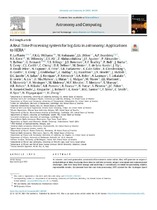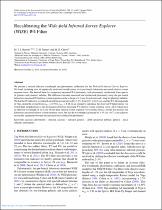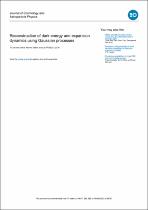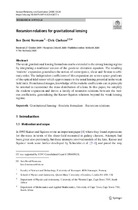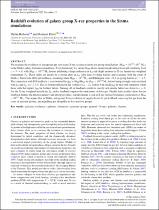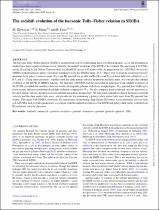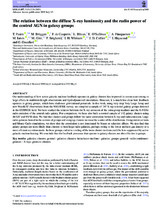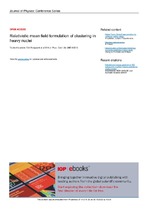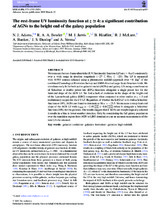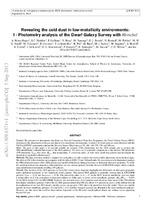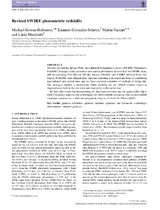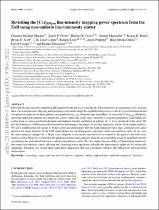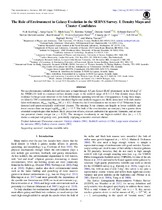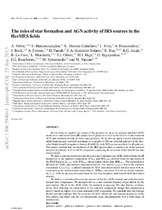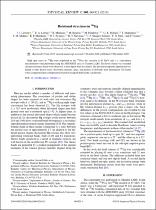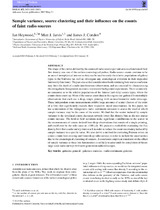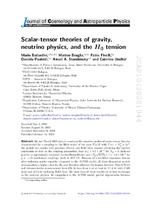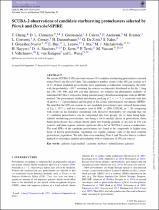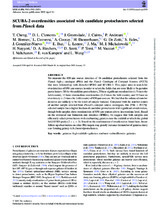Browsing Research Articles (Physics) by Title
Now showing items 415-434 of 510
-
A real time processing system for big data in astronomy: Applications to Hera
(Elsevier, 2021)As current- and next-generation astronomical instruments come online, they will generate an unprecedented deluge of data. Analyzing these data in real time presents unique conceptual and computational challenges, and their ... -
Recalibrating the Wide-field Infrared Survey Explorer (WISE) W4 Filter
(Cambridge University Press, 2014)We present a revised effective wavelength and photometric calibration for the Wide-field Infrared Survey Explorer W4 band, including tests of empirically motivated modifications to its pre-launch laboratory-measured ... -
Reconstruction of dark energy and expansion dynamics using Gaussian processes
(IOP Publishing, 2012)An important issue in cosmology is reconstructing the effective dark energy equation of state directly from observations. With few physically motivated models, future dark energy studies cannot only be based on constraining ... -
Recursion relations for gravitational lensing
(Springer Nature, 2019)The weak gravitational lensing formalism can be extended to the strong lensing regime by integrating a nonlinear version of the geodesic deviation equation. The resulting ‘roulette’ expansion generalises the notion of ... -
Redshift evolution of galaxy group X-ray properties in the SIMBA simulations
(Oxford University Press, 2023)We examine the evolution of intragroup gas rest-frame X-ray scaling relations for group-sized haloes (M500 = 1012.3–1015 M) in the SIMBA galaxy formation simulation. X-ray luminosity LX versus M500 shows increasing deviation ... -
The redshift evolution of the baryonic Tully-Fisher relation in SIMBA
(Oxford university press, 2021)The baryonic Tully–Fisher relation (BTFR) is an important tool for constraining galaxy evolution models. As 21-cm HI emission studies have been largely restricted to low redshifts, the redshift evolution of the BTFR is ... -
Reflectivity of VUV-sensitive silicon photomultipliers in liquid Xenon
(IOP Publishing, 2021)Silicon photomultipliers are regarded as a very promising technology for nextgeneration, cutting-edge detectors for low-background experiments in particle physics. This work presents systematic reflectivity studies of ... -
The relation between the diffuse X-ray luminosity and the radio power of the central AGN in galaxy groups
(Oxford University Press, 2020)Our understanding of how active galactic nucleus feedback operates in galaxy clusters has improved in recent years owing to large efforts in multiwavelength observations and hydrodynamical simulations. However, it is much ... -
Relativistic mean field formulation of clustering in heavy nuclei
(IOP, 2010)Very little is known about clustering in heavy nuclei and in particular the interaction between the correlated cluster nucleons and remaining core nucleons. Currently the phenomenological Saxon-Woods plus cubic Saxon-Woods ... -
The rest-frame UV luminosity function at z 4: A significant contribution of AGNs to the bright end of the galaxy population
(Oxford University Press, 2020)We measure the rest-frame ultraviolet (UV) luminosity function (LF) at z ∼ 4 self-consistently over a wide range in absolute magnitude (−27 ≲ MUV ≲ −20). The LF is measured with 46 904 sources selected using a photometric ... -
Revealing the cold dust in low-metallicity environments: I. Photometry analysis of the Dwarf Galaxy Survey with Herschel
(EDP Sciences, 2013)Context. We present new photometric data from our Herschel Guaranteed Time Key Programme, the Dwarf Galaxy Survey (DGS), dedicated to the observation of the gas and dust in low-metallicity environments. A total of 48 ... -
Revised SWIRE photometric redshifts
(Oxford University Press, 2013)We have revised the Spitzer Wide-Area Infrared Extragalactic survey (SWIRE) Photometric Redshift Catalogue to take account of new optical photometry in several of the SWIRE areas, and incorporating Two Micron All Sky ... -
Revisiting the [C ii]158𝝁��m line-intensity mapping power spectrum from the EoR using non-uniform line-luminosity scatter
(Oxford University Press, 2023)Detecting the line-intensity mapping (LIM) signal from the galaxies of the Epoch of Reionization is an emerging tool to constrain their role in reionization. Ongoing and upcoming experiments target the signal fluctuations ... -
The role of environment in galaxy evolution in the servs survey. I. density maps and cluster candidates
(The American Astronomical Society, 2020)We use photometric redshifts derived from new u-band through 4.5 μm Spitzer IRAC photometry in the 4.8 deg2 of the XMM-LSS field to construct surface density maps in the redshift range of 0.1–1.5. Our density maps ... -
The roles of star formation and AGN activity of IRS sources in the HerMES fields
(Oxford University Press, 2013)In this work we explore the impact of the presence of an active galactic nucleus (AGN) on the mid- and far-infrared (IR) properties of galaxies as well as the effects of simultaneous AGN and starburst activity in these ... -
Rotational structures in 196Hg
(University of the Western Cape, 2019)High spin states in 196 Hg were populated in the 198 Pt (α,6n) reaction at 65 MeV and γ −γ coincidence measurements were performed using the AFRODITE array at iThemba LABS. The level scheme was extended and new rotational ... -
Sample variance, source clustering and their influence on the counts of faint radio sources
(Oxford University Press, 2013)The shape of the curves defined by the counts of radio sources per unit area as a function of their flux density was one of the earliest cosmological probes. Radio source counts continue to be an area of astrophysical ... -
Scalar-tensor theories of gravity, neutrino physics, and the H0 tension
(IOP Publishing, 2020)We use Planck 2018 data to constrain the simplest models of scalar-tensor theories characterized by a coupling to the Ricci scalar of the type F(σ)R with F(σ) = N2 pl + ξσ2 . We update our results with previous Planck ... -
SCUBA-2 observations of candidate starbursting protoclusters selected by Planck and Herschel-SPIRE
(Royal Astronomical Society, 2019)We present SCUBA-2 850 μm observations of 13 candidate starbursting protoclusters selected using Planck and Herschel data. The cumulative number counts of the 850 μm sources in 9 of 13 of these candidate protoclusters show ... -
SCUBA-2 overdensities associated with candidate protoclusters selected from Planck data
(Oxford University Press, 2020)We measure the 850-μm source densities of 46 candidate protoclusters selected from the Planck high-z catalogue (PHz) and the Planck Catalogue of Compact Sources (PCCS) that were followed up with Herschel-SPIRE and SCUBA-2. ...

